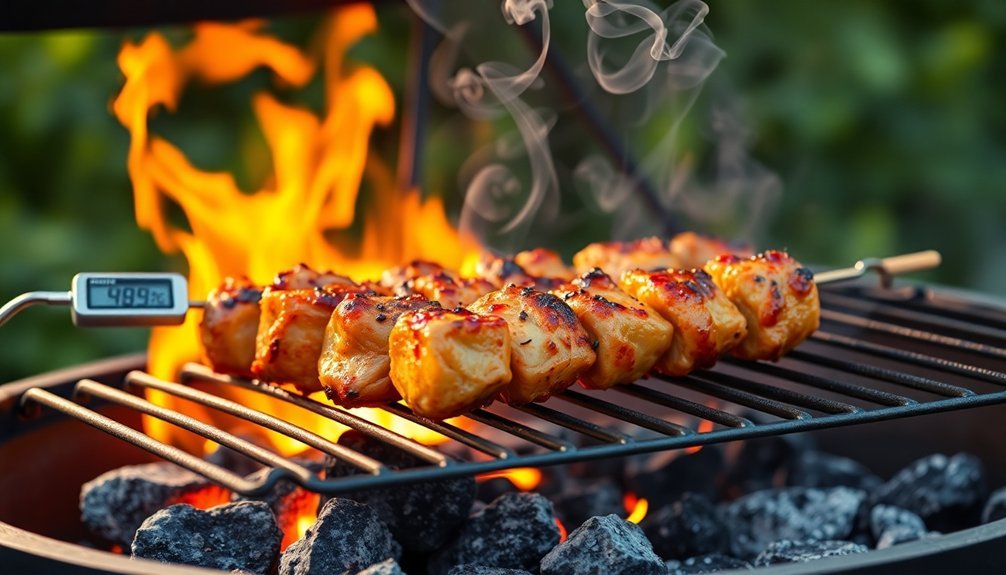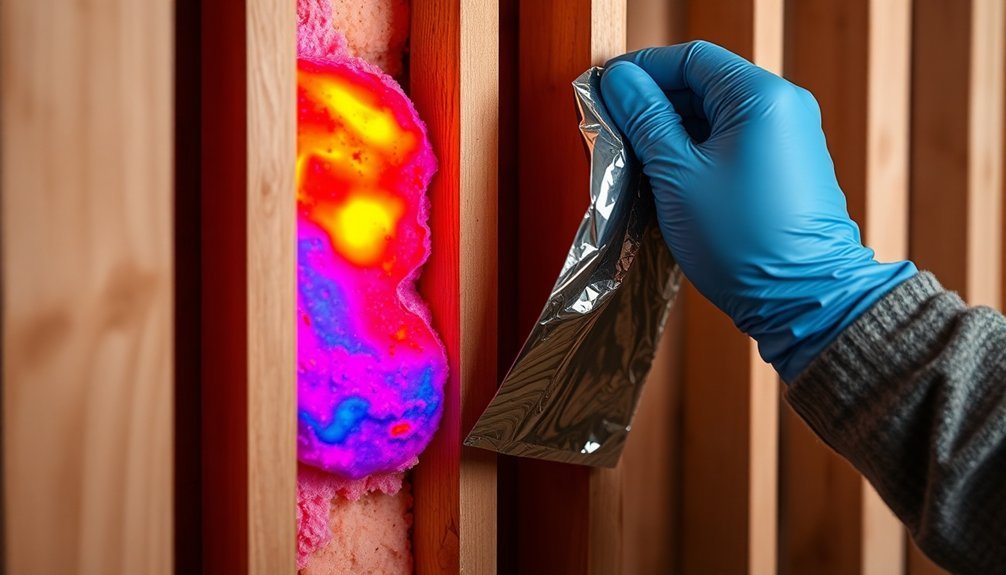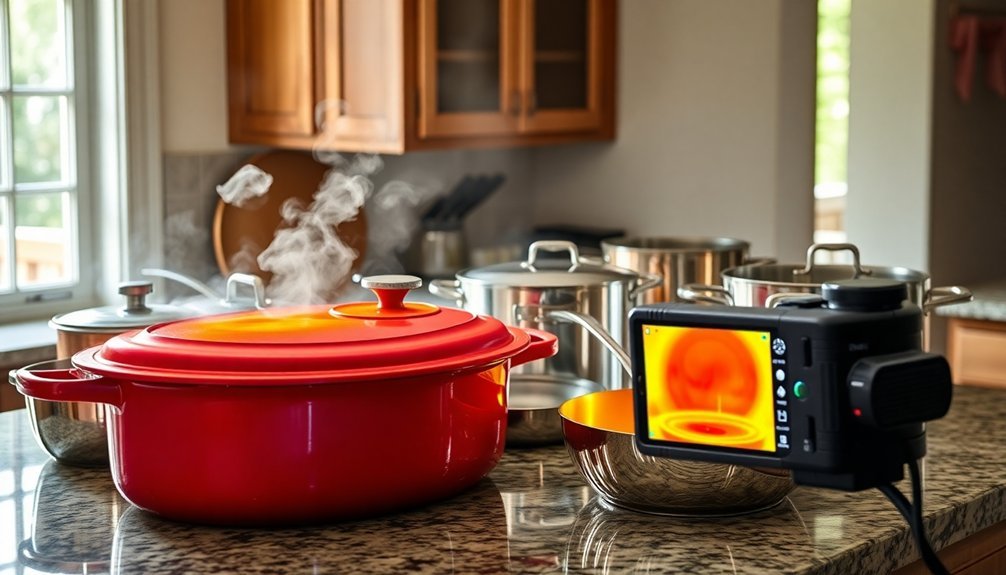To measure ingredients right for solar cooking success, you'll need basic measuring tools: dry cups, liquid cups, and measuring spoons. Start by cutting ingredients into uniform, smaller pieces for even cooking, and use accurate measurements to maintain proper ratios. Pack thick ingredients firmly into dry measuring cups, and use transparent cups with clear markings for liquids. When scaling recipes, multiply each ingredient by your conversion factor to maintain proportions. Choose containers that are slightly larger than conventional ones to allow proper heat circulation, and always use dark, insulated cookware for maximum sun absorption. Master these fundamentals to reveal the full potential of your solar cooking journey.
Basic Measurement Tools

Accuracy is the cornerstone of successful solar cooking, and having the right measurement tools is essential.
You'll need three main types of measuring equipment to get started: dry measuring cups, liquid measuring cups, and measuring spoons.
For dry ingredients like flour and sugar, you'll want a set of sturdy measuring cups that allow you to level off ingredients easily. A standard set includes ¼ cup, ⅓ cup, ½ cup, and 1 cup measures.
Choose transparent liquid measuring cups with clear markings and a spout for precise pouring of water, milk, and oils.
Don't forget a complete set of measuring spoons for smaller amounts of ingredients like spices and leavening agents. They should include ¼, ½, 1 teaspoon, and 1 tablespoon measures.
When measuring thick ingredients like yogurt or peanut butter, treat them as dry ingredients and pack them firmly into your measuring tools.
Converting Recipe Quantities
When adapting recipes for solar cooking, you'll often need to adjust ingredient quantities to match your desired servings.
Start by finding the original recipe's yield and divide your target servings by that number to get your conversion factor. For example, if you want to make 150 biscuits from a recipe that yields 75, your factor is 2.
Multiply each ingredient by your conversion factor to maintain proper proportions. Understanding both conversion methods enhances your ability to scale recipes accurately.
For accuracy, convert dry ingredients to weight measurements, but keep small quantities like spices in volume measures. You'll find it easier to use metric measurements, as they're more straightforward to convert.
However, liquid ingredients can often stay in volume measurements unless they're high in sugar content, like honey or syrup.
Remember to test your adjusted recipe to guarantee the results meet your expectations.
Scaling Portions for Solar Cooking

Success with solar cooking depends heavily on proper portion scaling and preparation techniques.
When scaling your recipes, cut ingredients into smaller, uniform pieces to guarantee faster and more even cooking throughout. You'll get better results with bite-sized portions rather than whole vegetables or large meat cuts. On longer cooking days, placing heavy materials like rocks inside your cooker helps maintain steady temperatures.
Remember that larger quantities and bigger pieces notably increase your cooking time. While a small solar cooker might handle rice for four people in 4 hours, you'll need to adjust portions based on your cooker's size and local conditions.
For best results, plan your cooking around peak sun hours – typically two hours before and after solar noon. Position your cooker to maximize sunlight exposure, and use dark-colored, well-insulated cookware to maintain consistent temperatures and cooking efficiency.
Liquid Ingredients in Solar Ovens
Proper handling of liquids in solar ovens requires specific techniques to achieve ideal results. You'll need to select heavy-duty plastic zip lock bags instead of glass containers, ensuring they're airtight and appropriately sized for your oven.
Position these containers to maximize sun exposure while using the black liner and insulation to maintain consistent temperatures up to 200°F.
For successful liquid cooking in your solar oven, follow these essential steps:
- Stir contents every 10 minutes using a spoon or stick
- Rotate containers regularly for even heat distribution
- Pre-heat your oven for up to an hour before cooking
- Use plastic wrap over the opening to trap heat
- Layer newspaper around containers for additional insulation
Dry Ingredient Ratios

Achieving perfect solar-baked goods depends heavily on your careful measurement of dry ingredient ratios.
You'll need to mix your flours strategically – try combining all-purpose flour with whole wheat flour in a 3:½ ratio for a balanced texture.
Don't forget to adjust these proportions based on your desired bread type and the protein content of your flours.
For best results, you'll want to include precise amounts of supporting dry ingredients: 1½ tablespoons of raw sugar to feed the yeast, 1½ teaspoons of salt to control fermentation, and measured portions of any leavening agents.
When you're adding extras like nuts or dried fruits, stick to standard measurements like 1 cup per batch.
Remember to mix all dry ingredients thoroughly before introducing any liquids – this guarantees even distribution and consistent baking results.
Moisture Content Adjustments
When working with solar food dehydration, understanding moisture content becomes your essential first step. Select fruits, vegetables, and herbs with high water content, but avoid overripe produce that won't dry properly.
You'll need temperatures between 85-100°F and humidity levels of 30-60% for ideal results.
- Position your drying racks to catch prevailing winds for enhanced moisture removal
- Use hygrometers and thermometers to monitor conditions constantly
- Spread items in a single layer on drying racks exposed to direct sunlight
- Rotate food regularly to guarantee even drying throughout the process
- Add reflective surfaces like aluminum foil to boost sun exposure
Track the process using built-in sensors for solar radiation, temperature, and air velocity.
You'll know you're successful when moisture levels drop consistently without damaging your food items.
Temperature Impact on Measurements

When you're measuring ingredients in sun-powered cooking, temperature greatly impacts your measurements, as hot ingredients occupy more volume than cold ones.
You'll need to account for how heat affects flour density, since warm flour can become more compact and throw off your measurements.
To maintain accuracy, let your ingredients reach a consistent room temperature before measuring, which helps guarantee reliable volume measurements across both dry and wet components.
Precise Volume in Heat
Precise measurements become increasingly critical as temperatures rise in solar cooking. You'll need the right tools to guarantee accuracy, as heat can greatly affect how ingredients behave.
Using appropriate measuring cups for liquids and dry ingredients, along with precise measuring spoons, helps maintain consistency in your sun-powered recipes.
- Use liquid measuring cups for fluids to prevent spillage as temperatures climb
- Level off dry ingredients with a straight edge, as heat can cause settling
- Rely on measuring spoons for small quantities of seasonings and leavening agents
- Consider a kitchen scale for the most accurate measurements
- Check ingredient volumes before and during cooking, as heat can cause expansion
Remember that temperature variations can affect cooking times and ingredient consistency.
When working with solar cooking, precision in measurement becomes your key to reliable results, guaranteeing your dishes cook evenly from edge to center.
Hot Vs Cold Ingredients
Temperature dramatically affects how ingredients behave during measurement and cooking in solar-powered food preparation. You'll need to monitor both hot and cold ingredients carefully to maintain food safety and achieve the finest results.
| Aspect | Hot Ingredients | Cold Ingredients |
|---|---|---|
| Safety Temp | Above 135°F (57.2°C) | Below 41°F (5°C) |
| Measuring Tips | Use heat-safe tools, work quickly | Level off precisely, avoid warming |
| Texture Impact | Can affect density, may spread | Maintains shape, better control |
| Storage | Keep in insulated containers | Use cold storage, chill properly |
| Best Practices | Check temps with thermometer | Measure while still cold |
Remember to calibrate your thermometers regularly and work efficiently when measuring hot ingredients to prevent temperature fluctuations. For cold ingredients, you'll want to maintain their chilled state throughout preparation to maintain accurate measurements and ideal results in your solar cooking.
Temperature Affects Flour Density
Building on our understanding of hot and cold ingredients, flour density presents a unique challenge in solar cooking measurement.
Temperature greatly impacts how flour behaves in your recipes, affecting both volume and weight measurements. When flour's temperature varies, its density changes, which can throw off your carefully planned solar cooking results.
To master temperature's impact on flour measurements:
- Use room temperature flour (75-78°F) for most consistent results
- Adjust your measuring technique in different weather conditions, as cold flour packs more densely
- Consider weighing flour instead of volume measurements for better accuracy
- Allow cold flour to warm naturally to room temperature before measuring
- Store flour in a temperature-controlled environment to maintain consistent density
Understanding these temperature effects helps you achieve reliable results in your sun-powered cooking adventures.
Container Size Guidelines
You'll need containers with airtight seals to maintain proper cooking temperatures and prevent moisture from escaping during solar cooking.
Choose vessels that offer adequate cooking space while maintaining an efficient ratio between the solar collection area and box volume.
Your containers should be slightly larger than what you'd use in a conventional oven, as solar cooking often requires more space for heat circulation and ideal performance.
Tight-Seal Container Selection
Selecting the right container size is essential for proper food preservation and storage. You'll need containers with tight-fitting lids and durable seals to protect your ingredients during the preservation process. Choose food-grade plastics or glass containers that won't absorb odors or flavors.
- Confirm your containers have leak-proof seals that can withstand repeated washing and normal use.
- Look for moisture-resistant materials that prevent vapor transfer and maintain food quality.
- Select containers that won't become brittle or crack when exposed to freezing temperatures.
- Check that lids fit tightly, using freezer tape for extra security if needed.
- Opt for containers no larger than half-gallon capacity for fruits and vegetables.
Remember to avoid using dairy cartons or containers without proper moisture barriers. Your containers should be easy to clean, stack, and label for efficient storage management.
Volume For Cooking Space
Proper volume management is essential for successful solar cooking. You'll want to choose containers that match both your serving needs and solar cooker capacity.
For small meals serving 1-2 people, stick with 1-2 quart saucepans (5.5-6.5 inches). When cooking for 3-4 people, opt for 3-4 quart containers (7-8 inches).
For larger gatherings, select 5-8 quart vessels (10 inches), which work well for pasta, seafood, or big batches of soup.
Remember that thicker pots retain heat better in your solar cooker, making them more efficient. Always match your container size to your cooking needs – too large a pot wastes energy, while too small a container mightn't hold enough food for your group.
Seasonal Ingredient Modifications

When crafting solar-cooked dishes, seasonal ingredients play a vital role in achieving ideal results. You'll need to adapt your recipes based on what's fresh and available in your local market.
Different vegetables release varying amounts of water during cooking, so adjust your liquid measurements accordingly, especially with water-rich ingredients like zucchini.
- Use thin, uniform slices for vegetables to guarantee even cooking
- Mix seasonal vegetables with cream and seasonings before cooking
- Substitute ingredients while considering their moisture content and cooking times
- Choose local produce for peak freshness and flavor
- Maintain consistent cutting sizes across all ingredients
Remember to modify cooking times based on your chosen vegetables, as denser ingredients like potatoes will need longer exposure than tender ones.
You'll get the best results by balancing flavors and textures while working with nature's seasonal offerings.
Timing and Portion Control
You'll need to carefully measure your ingredients while keeping track of available sunlight hours to guarantee successful solar cooking.
Make sure you're adjusting portion sizes based on the season's peak sunlight periods – using smaller portions during shorter winter days and larger ones during extended summer daylight.
Watch your timing closely as you measure, since proper portioning helps maintain consistent cooking times and guarantees your meal will be ready during prime sunlight hours.
Adjust Portions Per Sunlight
Successfully timing your solar cooking requires careful attention to both portion sizes and available sunlight.
You'll need to adjust your cooking schedule based on sunlight intensity and understand that cloudy conditions will extend cooking times. For peak results, use black cooking containers to maximize heat absorption and match your portions to your solar cooker's capacity.
- Monitor sunlight conditions throughout the day – morning sun differs from afternoon intensity
- Choose appropriate container sizes and colors (black works best) for your portions
- Keep portions balanced to guarantee even cooking and prevent under or overheating
- Consider using insulated bags to continue slow cooking when sunlight diminishes
- Adjust recipe quantities based on your solar cooker's size and the day's available sunlight
Remember to maintain safe food temperatures above 140°F (60°C) and use a thermometer to verify doneness.
Watch Time While Measuring
Three key elements must align for effective solar cooking: precise timing, accurate measurements, and proper portioning.
You'll need to add extra time when trying new solar recipes, as unfamiliar steps can slow you down. Write down your timing estimates, including "hidden" periods for chilling, resting, or marinating.
Keep track of idle times when the food's cooking in the sun.
For best results, maintain standardized measurements, especially for critical ingredients like spices. You'll want to monitor your solar cooker's temperature closely and adjust the focal point as needed.
Don't forget to use black pots to enhance energy absorption and speed up cooking.
Plan ahead by identifying needed utensils and recording any adjustments you make. This documentation will help you improve your solar cooking efficiency over time.
Storage and Preservation Measurements

Proper storage measurements make the difference between preserved and spoiled ingredients in sun-powered food preparation.
You'll need to maintain specific temperatures and conditions to guarantee your ingredients last until you're ready to use them.
- Keep your refrigerator at 40°F (4°C) and freezer at 0°F (-18°C) for peak preservation
- Store up to 17 lbs of white enriched flour for long-term use
- Measure shelf space for dry ingredients at least 6 inches off the floor
- Allow proper spacing between stored items for air circulation
- Track expiration dates: one year for peanut butter and ready-to-eat cereals
When storing canned goods, you'll get 2-5 years of shelf life for commercial meat, poultry, and fish products.
For dried ingredients like beans and lentils, measure out 1-2 years' worth of storage space in a cool, dark location.
Frequently Asked Questions
How Do Altitude Changes Affect Ingredient Measurements in Solar Cooking?
You'll need to increase liquids by 10-25% as you climb higher in elevation. Above 8,000 feet, add 25% more liquid, and expect longer cooking times due to faster evaporation in solar cooking.
Can Metal Measuring Tools Interfere With Solar Oven Performance?
Yes, your metal measuring tools can affect solar oven performance by conducting heat away, casting shadows, or reflecting sunlight incorrectly. It's best to use non-metallic measuring tools and remove them after measuring ingredients.
Do Ingredient Measurements Change When Cooking on Consecutive Cloudy Days?
No, you'll need to keep your measurements exactly the same on cloudy days. While you might need to extend cooking times or split recipes across multiple days, don't alter your ingredient quantities for consistent results.
Should Spice Quantities Be Adjusted Differently for Morning Versus Afternoon Cooking?
You don't need to adjust spice quantities based on morning or afternoon cooking times. Focus instead on your cooking method, desired flavor profile, and proper timing of spice addition for ideal taste development.
Does Food Coloring Affect How Ingredients Absorb Heat in Solar Cooking?
You don't need to worry about food coloring affecting heat absorption in solar cooking. It's the natural color and material of your cookware and food that matters more for absorbing and retaining heat effectively.
In Summary
You'll find success in solar cooking by carefully measuring and adapting your ingredients. Keep your measurement tools calibrated, convert recipes accurately, and adjust portions for solar-specific cooking. Remember to scale liquid ratios properly and maintain precise dry ingredient measurements. With proper container sizing and seasonal modifications, you're set to create perfectly portioned sun-cooked meals that store well for future enjoyment.





Leave a Reply